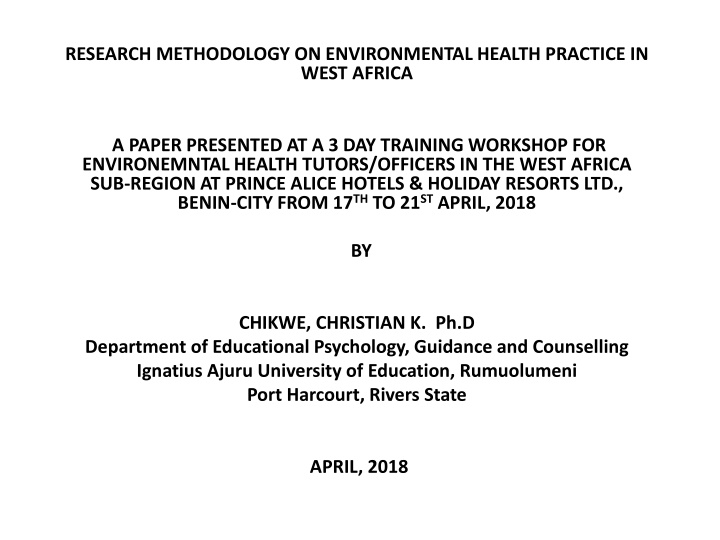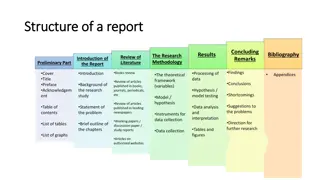Research Methodology in Environmental Health Practice: Key Components
Research methodology in environmental health practice is crucial for generating reliable data and meaningful results. It encompasses steps such as study design, data collection, and analysis methods like surveys and descriptive studies.
Download Presentation

Please find below an Image/Link to download the presentation.
The content on the website is provided AS IS for your information and personal use only. It may not be sold, licensed, or shared on other websites without obtaining consent from the author.If you encounter any issues during the download, it is possible that the publisher has removed the file from their server.
You are allowed to download the files provided on this website for personal or commercial use, subject to the condition that they are used lawfully. All files are the property of their respective owners.
The content on the website is provided AS IS for your information and personal use only. It may not be sold, licensed, or shared on other websites without obtaining consent from the author.
E N D
Presentation Transcript
RESEARCH METHODOLOGY ON ENVIRONMENTAL HEALTH PRACTICE IN WEST AFRICA A PAPER PRESENTED AT A 3 DAY TRAINING WORKSHOP FOR ENVIRONEMNTAL HEALTH TUTORS/OFFICERS IN THE WEST AFRICA SUB-REGION AT PRINCE ALICE HOTELS & HOLIDAY RESORTS LTD., BENIN-CITY FROM 17THTO 21STAPRIL, 2018 BY CHIKWE, CHRISTIAN K. Ph.D Department of Educational Psychology, Guidance and Counselling Ignatius Ajuru University of Education, Rumuolumeni Port Harcourt, Rivers State APRIL, 2018
Introduction Research methodology is an important component of the research project. It lays out the procedures and methods the researcher adopts in carrying out an investigation. This section leads to a better interpretation of the research findings or results. A builder who builds without a plan will have a shapeless and ugly house. A research without methodology will lead to meaningless research that will not contribute to knowledge. This paper therefore, takes a look at research methodology in environmental health.
Definitions Research methodology: Description of the steps used in the execution of a study in environmental health. Environmental health: Aspects of human health, including quality of life, that are determined by physical, chemical, biological, psychological factors environment. social, in and the
Importance of Research Methodology Offers readers the opportunity to know how the data was generated. This is because the method chosen affects the interpretation of findings To show clearly the reasons why a particular procedure was adopted for study To allow other researchers adopt or replicate the methodology used for a particular study. This information is particularly useful when a new method has been developed or an innovative use of an existing one is utilized The readers want to know that the data was collected or generated in a way that is consistent with acceptable practice in the field of study
Parts of Research Methodology in Environmental Health Designs Population Sample Instrumentation Data Analysis
Research Designs Survey Descriptive Analytic
Descriptive Study This is a detailed and quantified description of population. Surveys involve the systematic collection of data through the use of observational methods, interviews and questionnaires. Cross-sectional studies: They collect data from samples at one point in time. The researcher collects data from different samples and studies them at a given point in time. Longitudinal studies: These are studies that collect data on the same sample over a long period of time
Analytic Studies They are studies used for testing of hypotheses concerning the relationship between variables, magnitude of the relationship and its statistical significance Experimental designs: They seek to establish cause-and effect relationships. Two types of variables are involved, the independent and dependent variables. There are three types of experimental designs: True- experimental designs: they involve random selection and random assignment of samples into groups of the study. The investigator has complete control over extraneous variables. Examples of this design include post-test only, pre-test-post-test only, Solomon four group, etc. Quasi experimental designs: they are not true experimental designs because random selection and assignment into groups are not observed. Examples include non-equivalent groups, pretest-posttest designs. Pre-experimental designs: This is the type of design where either a single group or groups are observed subsequent to treatment that presumed to cause the change There is no control group to make comparison. Example include one shot case design, posttest only, design.
Population Target Accessible Finite Infinite Sample Sampling unit Sampling design Sampling frame
Sample Techniques Probability and non-probability sampling techniques Probability sampling techniques Simple random sampling Stratified random sampling Systematic sampling Proportionate Sampling Cluster sampling Multi-stage sampling
Sample Techniques Non-probability sampling techniques quota sampling convenience sampling purposive sampling
Instrumentation Observation Guidelines for observation Interview Structured interview Semi-structured interview Unstructured interview Guidelines for conducting a good interview Questionnaire Opened ended Close ended Guidelines in questionnaire construction
Data Analysis Technique Qualitative research data analysis (Nominal and Ordinal data) frequency count percentages chi-square Quantitative research data analysis (Interval and ratio data) mean standard deviation analysis of variance (ANOVA)
Summary The various components of the research methodology is summarized according to Ugodulunnwa ( 2006) as follows: Research Design Should be appropriate Mention design, describe it and how it is study (i.e. plan of the design) adopted in your Population and Sample Mention population and describe its characteristics and context Mention and describe the distribution of sample according to study variables Give proportion of the population that constitutes the sample
Sampling Technique Mention the sampling technique(s) to be adopted and describe it Describe how the sampling technique is applied in sample selection Justify choice of the sampling technique Present distribution of population and sample in a table Instrumentation Description of Instrument Name each instrument to reflect what it measures Describe the components of each instrument Instrument Development Procedure out in stages Indicate whether the instrument is adopted or adapted or Developed Describe how the adoption or adaptation or development was carried Do that for each instrument if they are more than one Validity and Reliability
Data Collection State how permission was sought from authorities to collect data from the sample Describe how research assistants were trained and used for data collection (their number, qualification, gender, training given and why need to be provided) Describe how each instrument was administered Mention duration of data collection Describe how each instrument was scored If it is an experimental study o Describe treatment package/intervention/programme o Describe treatment given to the experimental group o Describe placebo that was given to the control group Data Analysis Present data analysis techniques you used for each research question and/or hypothesis Describe how and why each technique is applied























